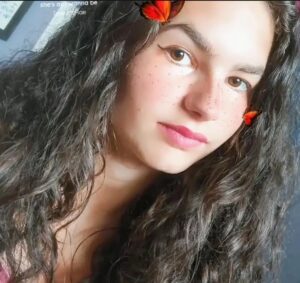Katie Brown, age 15, loves learning Spanish, swinging, and special effects makeup. In the future, she is considering a possible career as a writer or a special effects artist; she loves animals, especially the family’s dogs. Though Katie has faced many challenges in her life—from learning to manage autism to being diagnosed with precocious puberty and ZMYM2-related disorder—Katie faces each day with excitement and empathy. Her mother Sharon says:
“I am so grateful for Katie and what she has taught me about patience and understanding. She has made me such a better parent.”
To Sharon, being a good parent means always advocating for your child, doing whatever you can to help them succeed, thrive, and live a happy, full life. While Sharon is currently thrilled with everything that Katie has accomplished, the future is uncertain; there are fewer than 100 people in the world with ZMYM2-related disorder and Katie may be one of the oldest.

Sharon is passionate about raising awareness and is resolved in her mission to advance ZMYM2 knowledge and understanding. Finding available research is hard; pushing for new research is even more difficult. Says Sharon:
“That’s why I continue to look for answers. If I’m not searching for new information, I feel like I’m failing as a parent. I’m not giving up and I need other people to know that they shouldn’t give up either.”
Recently, Sharon sat down with Patient Worthy to discuss Katie’s diagnostic journey, why research and advocacy are so urgently needed, and how Katie is doing today. She is very interested in speaking with any researchers who are interested in ZMYM2-related disorder and urges anybody with an interest to please reach out after reading Katie’s story.
Katie’s Story
When Sharon went to her eight-week pregnancy scan, she expected to hear positive news about her growing daughter. Instead, the doctor noted that Katie’s yolk sac was still visible, which it shouldn’t be. As the pregnancy progressed forward, the doctor’s concerns solidified. Says Sharon:
“The doctor didn’t know if it was spina bifida or a teratoma. They gave us a 10% survival rate at 16 weeks and recommended termination. I understand why, especially when considering Mirror Syndrome, which is when the baby experiences difficulty with the heart or kidneys that transfers over to the mom. But for me, I had to give my daughter a chance at life. And looking at her now, I’m so glad I said no.”
Katie was eventually born with a type IV sacrococcygeal teratoma, a tumor that develops before birth and grows from the coccyx (tailbone). Type IV sacrococcygeal teratomas are completely internal and are considered more serious than other subtypes, which are typically external. Four days later, Katie underwent surgery to remove her coccyx and two sacral vertebrae. Sharon shares:
“Many children with sacrococcygeal teratomas have kidney and urinary tract issues, which some doctors and parents believe is due to the surgery. We’re lucky that Katie has no spinal cord, kidney, or urinary tract issues.”
The Diagnostic Journey
Katie recovered well from her surgery and, for the next few years, seemed to be progressing nicely. Her bedroom walls were papered with large, colorful, laminated pictures of numbers, shapes, and the alphabet. Sharon loved singing “Twinkle Twinkle Little Star” to help Katie drift off to peaceful sleep. Katie was a late talker and walker, which didn’t really stick out to her parents at first. Sharon shares:
“We assumed that some of the delays were due to the teratoma, which is why we didn’t immediately think that something was wrong. I was also very involved in a mom’s group where we did lots of activities with the children: swimming, gymnastics, ballet, walking, socializing. Katie has always been really social and enjoyed these.”
But Sharon became concerned when, in kindergarten, Katie still didn’t know her ABCs or how to count. Over winter break, her parents realized that Katie forgot how to spell her name. From that point, Sharon says:
“Reality hit me, and I realized that something was going on. Before that, I had been in complete denial. My other daughter was very advanced. She walked early, talked early, did everything early basically. So with Katie, we just thought she was more laidback. When we started noticing these issues, her teacher suggested that it might be autism. I asked doctors about it and they told me that she was too young to be screened, which didn’t sit right with me.”
Around seven and a half years old, Katie began having left temporal lobe seizures and motor seizures. The corner of her mouth would twitch, often so briefly that her parents thought it was a quirk. Then, on a trip to Disney world, Sharon says:
“We sat at a traffic light for about a minute and a half. The entire time, one side of her mouth was twitching and seizing. She was so thrilled and so excited, just talking about Magic Kingdom, but I couldn’t stop looking at her mouth not moving on one side. I’ve worked in cardiac rehab before and wondered if it was a stroke, but she was blinking and able to talk.”
Eventually, the family took Katie to Nemours Children’s Health in Jacksonville, where she was evaluated by a neurologist. An MRI showed that Katie had a 5mm x 5mm cyst or tumor on her pituitary gland, which doctors suspected was a Rathke cleft cyst that did not go away during prenatal development. During this time, and given Katie’s history, the neurologist also referred the family to an endocrinologist.
Join us in Part 2 of Katie’s story, where we’ll discuss precocious puberty, whole exome sequencing, and discovering that Katie has a rare condition called ZMYM2-related disorder.


